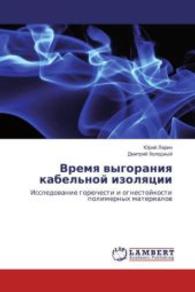- ホーム
- > 洋書
- > 英文書
- > History / World
Full Description
Arguing that sound is integral to Virginia Woolf's understanding of literature, Elicia Clements highlights how the sonorous enables Woolf to examine issues of meaning in language and art, elaborate a politics of listening, illuminate rhythmic and performative elements in her fiction, and explore how music itself provides a potential structural model that facilitates the innovation of her method in The Waves.
Woolf's investigation of the exchange between literature and music is thoroughly intermedial: her novels disclose the crevices, convergences, and conflicts that arise when one traverses the intersectionality of these two art forms, revealing, in the process, Woolf's robust materialist feminism. This book focuses, therefore, on the conceptual, aesthetic, and political implications of the musico-literary pairing. Correspondingly, Clements uses a methodology that employs theoretical tools from the disciplines of both literary criticism and musicology, as well as several burgeoning and newly established fields including sound, listening, and performance studies. Ultimately, Clements argues that a wide-ranging combination of these two disciplines produces new ways to study not only literary and musical artifacts but also the methods we employ to analyze them.
Contents
Acknowledgments
Abbreviations
Introduction
I. Woolf's Musical Ear
II. Interdisciplinary Methods
III. "Hoity te, hoity te, hoity te ...": Tripartite Woolf
Part 1 An Emerging Earcon: Woolf's Singers
1. Finding a Voice
I. Resonant Beginnings: The Voyage Out
II. Sonic Networks in Jacob's Room
III. Urban and Rural Interrelations in Mrs. Dalloway and To the Lighthouse
2. The Earcon Reproduces
I. "And what is a cry?": The Waves
II. Integrating the Earcon in The Years
III. Aural Multiplicity in Between the Acts
Part 2 Profound Listening and Acousmatics
3. Initial Apperceptions
I. Materialized Sonics and Listening Subjects in The Voyage Out
II. Involuntary, Yet Profound, Listening in Night and Day
III. International Acousmatics: War and Its Veterans in Jacob's Room and Mrs. Dalloway
4. Bodies and Voices
I. To the Lighthouse and Family Acousmatics
II. The Gender of Listening in The Waves
III. "Hush!... Somebody's listening": The Years
IV. Heterogeneous Reattachments in Between the Acts
Part 3 Music as Performance in Woolf's Fiction
5. Performing Women
I. Women at the Piano in the First Three Novels
II. Performing Personal History in The Years
III. Historical Reenactments: Between the Acts
6. The Performativity of Language: The Waves Musicalized
I. Word Music: "(The rhythm is the main thing in writing)"
II. The Case of Ludwig van Beethoven
III. Transforming Beethoven's Opus 130 and 133 into Words
Coda: A Meditation on Rhythm
Notes
Works Cited
Index







